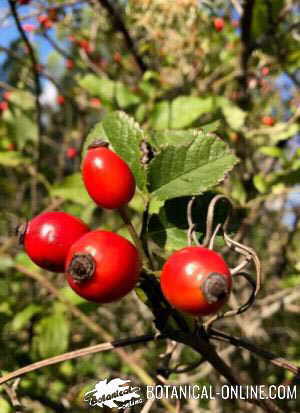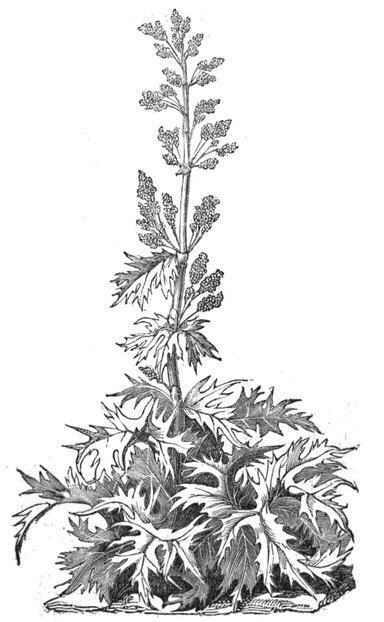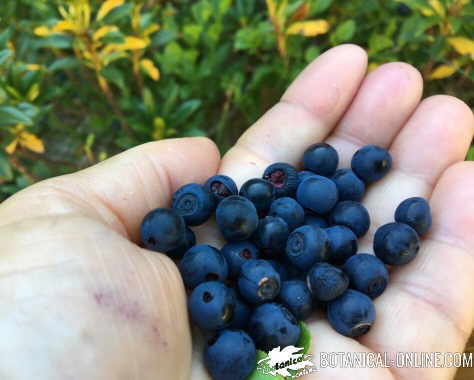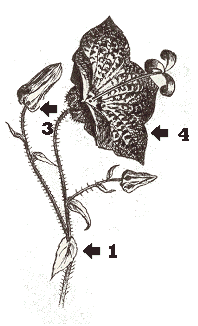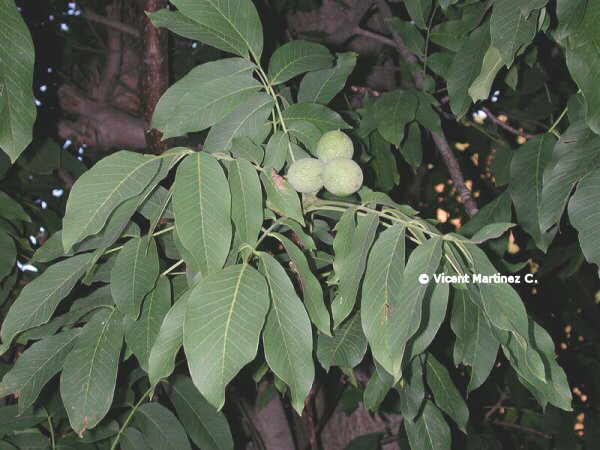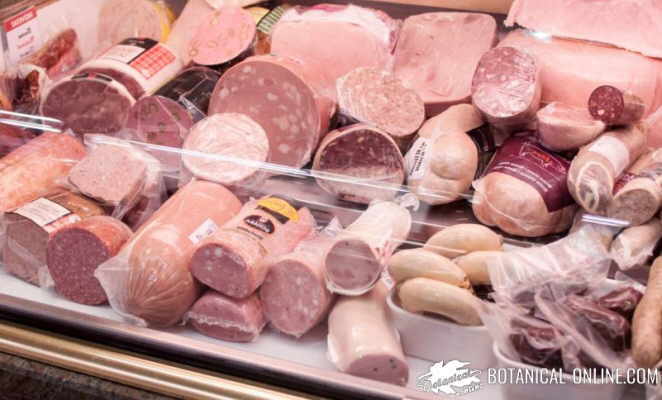Contents
EDIBLE PROPERTIES OF PEANUTS
PEANUTS NUTRITION
Peanuts and proteins
From an edible point of view, peanuts are considered to belong to the nuts group, like, for example, almonds, hazelnuts or walnuts.
From a botanical standpoint, peanuts are legumes, like soybeans, lentils or chickpeas. Peanuts are rich in protein, vitamin B and fat.
Groundnuts or peanuts are rich in protein
They contain high quality proteins with all the amino acids. In this sense, they are richer than soybeans, which are very famous for their richness in proteins.
Protein content of peanuts almost equals that of beef in many amino acids and exceeds it in others, as in the case of arginine (3, 085 g per 100 g in peanuts compared to 1.996 g of beef).
Two tablespoons of peanut butter are richer in protein than an egg. (See box below to view the protein content of this legume compared to that of beef)
| Amino acids in peanuts, soybeans and beef per 100 gr. | |||
| Amino acids | Cooked soybeans with no salt | Raw peanuts with no salt | Lean beef- fat separated |
| Tryptophan | 0,242 g | 0,250 g | 0,354 g |
| Threonine | 0,723 g | 0,883 g | 1, 380 g |
| Isoleucine | 0,807 g | 0,907 g | 1, 420 g |
| Leucine | 1,355 g | 1,672 g | 2, 497 g |
| Lysine | 1,108 g | 0,926 g | 2, 628 g |
| Methionine | 0,224 g | 0,317 g | 0,809 g |
| Cystine | 0,268 g | 0,331 g | 0,354 g |
| Phenylalanine | 0, 869 g | 1,337 g | 1,233 g |
| Tyrosine | 0,630 g | 1,049 g | 1,061 g |
| Valine | 0,831 g | 1,082 g | 1,536 g |
| Arginine | 1, 291 g | 3, 085 g | 1, 996 g |
| Histidine | 0, 449 g | 0, 652 g | 1, 082 g |
| Alanine | 0, 784 g | 1, 025 g | 1,905 g |
| Aspartic acid | 2, 093 g | 3, 146 g | 2,886 g |
| Glutaminic acid | 3, 224 g | 5, 390 g | 4,746 g |
| Glycine | 0,770 g | 1,554 g | 1,723 g |
| Proline | 0,974 g | 1,138 g | 1,395 g |
| Serine | 0, 965 g | 1,271 g | 1, 208 mg |
Peanuts and fats
Peanuts are foods rich in fat. They contain nearly 50% fat of which almost 70% are unsaturated. Among them the main are oleic and linoleic (Omega 6). Both are extremely important in controlling cholesterol. (See peanuts and cholesterol).
They also play a key role in controlling inflammation of the body, especially omega 6.
Including peanuts in the diet will also help control inflammatory processes in diseases such as rheumatoid arthritis and premenstrual syndrome.
Eating peanuts can help keep the blood more fluid, preventing the formation of blood clots that are responsible for the occurrence of strokes, embolism and other circulatory problems.
The fat content of peanuts makes them a great help in situations that require access to a vast reservoir of energy: hard work, sports, games and more. Peanuts are ideal for eating out because they are easily transportable.
For example, children are highly recommended to include them in the midmorning snack or playtime.
However, in spite of their edible virtues, we must bear in mind that we must be prudent to use them moderately, especially in cases of overweight or obesity.
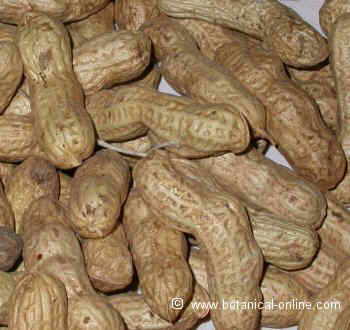
Photo of peanuts
Minerals in peanuts
Peanuts are rich in minerals. We should mention their content in potassium, a mineral that is very interesting for the control of fluids in the body. Raw peanuts are one of the foods richest in potassium.
Potassium counteracts peanuts content in sodium. Raw peanuts have 705 mg of potassium per 100 g. they far outweigh soybeans (515 mg/100 g), walnuts (441 mg/100g) or bananas (396 mg/100g) In fact, they are only surpassed by some beans containing 1300 mg / 100 g.
The potassium content in raw peanuts can help control high blood pressure or prevent fluid retention.
The phosphorus content of peanuts is very high. Although not reaching the level of wheat germ, or oatmeal, they have a similar content to that of wheat or nuts. Peanuts may contribute to the health of our bones or to the growth in children.
Iron is the third very prominent mineral in peanuts. Iron, among other properties, is necessary to prevent anemia. Peanuts contain 4.5 mg of iron per 100 g.
They are one of the most prominent food in this mineral. Exceeded by soybean (5.1 mg) and other foods such as hazelnuts (4.7 mg), its content is much higher than most plant foods, of course much more than spinach, which have the reputation of being very rich in iron, although its amount is much lower than that of peanuts. (1.5 mg, when raw; 0.8 mg, when boiled)
Zinc, copper and magnesium are also minerals that appear in high proportion in peanuts.
Vitamins in peanuts
Peanuts are particularly interesting in vitamin B, especially folic acid or niacin. More information about “Vitamins in peanuts”.
Antioxidant properties of peanuts
Peanuts, like black grapes are rich in resveratrol, a component with outstanding antioxidant properties.
The properties of resveratrol in controlling cholesterol and preventing circulatory diseases has been widely highlighted in many studies. (More information on “Peanuts properties ” in the listing below)
The peanut plant
When tender, the fruit pods and most tender leaves of the peanut plant can be cooked as a vegetable.
Allergy to peanuts
Some people are allergic to peanuts. If these people eat this food, they can develop a food allergy whose results may even lead to anaphylactic shock with very serious consequences.
These people should not eat peanuts, peanut butter or other products containing this vegetable.
Women during pregnancy or breastfeeding, should also refrain from eating peanuts if they have any history of allergy in their family or have had an allergic reaction before pregnancy.
Eating this food during these times could sensibilize the fetus or nursing baby against this food, so it would be more prone to food allergies in the future. (See allergy to peanuts)
Non suitable for people with weak stomachs
Peanuts, like other legumes, may be indigestible for those who have trouble in digesting food properly. In these cases, they should eat them in small amounts and chew them thoroughly.
Roasted peanuts are digested better, but they are poorer in vitamins. In any case they should be eaten without salt.
Also, because of their fat content, peanuts are not recommended for those people who have problems of lack of bile, liver patients or people with delicate pancreas.
Problems of raw peanuts
Raw peanuts have outstanding food properties. However, we must bear in mind that raw peanuts, like other foods from this group, when stored in poor conditions, may be contaminated with fungi that can be very harmful to health.
Raw nuts, such as walnuts, hazelnuts and other nuts can develop aflatoxins which are carcinogens.
| Composition of peanuts and almonds per 100 g | |||
| Nutrient content | Raw peanuts without salt | Cooked peanuts with salt | Roasted almonds with salt |
| Water | 6,5 g | 41,78 g | 2,6 g |
| Energy | 567 Kcal | 318 Kcal | 597 Kcal |
| Fat | 6,3 g | 22,01 g | 52,83 g |
| Protein | 49,24 g | 49,24 g | 22,09 g |
| Carbohydrates | 16,14 g | 13,50 g | 11,8 g |
| Fiber | 8,5 g | 8,8 g | 8,8 g |
| Potassium | 705 mg | 180 mg | 746 mg |
| Sodium | 18 mg | 751 mg | 339 mg |
| Phosphorus | 376 mg | 198 mg | 489 mg |
| Calcium | 92 mg | 55 mg | 266 mg |
| Magnesium | 168 mg | 102 mg | 286 mg |
| Iron | 4,58 mg | 4,58 mg | 4,51 mg |
| Zinc | 3,27 mg | 1,01 mg | 3,54 mg |
| Copper | 1,144 mg | 0,499 mg | 1,170 mg |
| Vitamin C | 0 | 0 | 0 |
| Vitamin B1 | 0,640 mg | 0,259 mg | 0,074 mg |
| Vitamin B2 | 0,135 mg | 0,063 mg | 0,859 mg |
| Vitamin B6 | 0, 348 mg | 0, 152 mg | 0, 126 mg |
| Vitamin A | 0 IU | 0 IU | 1 IU |
| Vitamin E | 9,13 mg | 3,170 mg | 26,30 mg |
| Folacin | 240 mcg | 75 mcg | 33 mcg |
| Niacin | 12,06 mg | 5,259 mg | 3,850 mg |
![]() More information about peanut.
More information about peanut.

